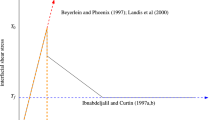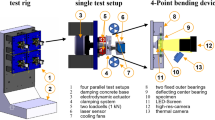Abstract
This paper investigates the influence of fibre volume fraction on the mode I interlaminar fracture toughness G Ic of a glass-fibre/vinyl ester composite. Two fibre volume fraction parameters are defined; a global value for the composite specimen and a value for the fibre-dense intralaminar regions. The range of global fibre volume fraction studied was 32–52 %. Results show that G Ic values for crack initiation are independent of fibre volume fraction and similar to matrix resin G Ic . Variations in the G Ic for steady-state crack propagation, and the amount of fibre bridging, are not completely explained by changes in global fibre volume fraction. Instead they are consistent with fibre volume fraction in the fibre-dense intralaminar regions, through which the crack preferred to grow. It is concluded that this latter parameter is more relevant for G Ic characterisation as a function of fibre volume fraction.
Similar content being viewed by others
References
Protocols for Interlaminar Fracture Testing of Composites, European Structural Integrity Society (ESIS), Delft, The Netherlands, 1993.
Standard Test Method for Mode I Interlaminar Fracture Toughness of Unidirectional Fiber-Reinforced Polymer Matrix Composites, ASTM D5528-94a, American Society for Testing and Materials, Philadelphia, Pennsylvania, 1994.
Testing Methods for Interlaminar Fracture Toughness of Carbon Fibre Composites. JIS K7086-1993, Japanese Industrial Standards Group, Tokyo, Japan, 1993.
Williams, J. G., Davies, P., and Brunner, A. J., 'Standard Test for the Toughness of Composite Laminates — Some Bones of Contention', Proc. ICCM-10, A Poursartip and K. Street (eds.), Woodhead Publishing Ltd., Whistler B.C., Canada, 1995, Vol. I, pp. 71-75.
Davies, P., 'Round Robin Analysis of G Ic Interlaminar Fracture Test', Applied Composite Materials 5, 1996, 135-140.
Russell, A. J., 'Micromechanisms of Interlaminar Fracture and Fatigue', Polymer Composites 8(5), 1987, 342-351.
Bradley, W. L., 'Relationship of Matrix Toughness to Interlaminar Fracture Toughness', in Application of Fracture Mechanics to Composite Materials, K. Friedrich (ed.), Elsevier, 1989.
Hunston, D. L., Moulton, R. J., Johnston, N. J., and Bascom, W. D., 'Matrix Resin Effects in Composite Delamination: Mode I Fracture Aspects', in Toughened Composites, ASTM STP 937, Norman J. Johnston (ed.), American Society for Testing and Materials, Philadelphia, 1987, pp. 74-94.
Marom, G., Roman, I., Harel, H., Rosensaft, M., Kenig, S., and Moshonov, A., 'The Strain Energy Release Rate of Delamination in Fabric-reinforced Composites', International Journal of Adhesion and Adhesives 8(2), 1998, 85-91.
Davies, P., Cantwell, W., Moulin, C., and Kausch, H.-H., 'A Study of the Delamination Resistance of IM6/PEEK Composites', Composites Science and Technology 36, 1989, 153-166.
Robinson, P. and Song, D. Q., 'A Modified DCB Specimen for Mode I Testing of Multidirectional Laminates', Journal of Composite Materials 26(11), 1992, 1554-1577.
Burchill, P. and Simpson, G., 'Improved Interlaminar Fracture Toughness for Vinyl Ester Resin-Fibre Glass Composites', Proc. ICCM-11, M. Scott (ed.), Woodhead Publishing Ltd., Gold Coast, Australia, 1997, vol. II, 254-262.
Hull, D., An Introduction to Composite Materials, Cambridge University Press, 1981.
Standard Test Methods for Plane-Strain Fracture Toughness and Strain Energy Release Rate of Plastic Matertials, ASTM D5045-91a, American Society for Testing and Materials, Philadelphia, Pennsylvania, 1991.
Standard Test Method for Tensile Properties of Plastics, ASTM D638M-91a, American Society for Testing and Materials, Philadelphia, Pennsylvania, 1991.
Matthews, F. L. and Rawlings, R. D., Composite Materials: Engineering and Science, Chapman and Hall, London, 1994.
Hashemi, S., Kinloch, A. J., and Williams, J. G., 'Corrections Needed in Double Cantilever Beam Tests for Assessing the Interlaminar Failure of Composites', Journal of Materials Science Letters 8, 1989, 125-129.
Compston, P. and Jar, P.-Y. B., 'Comparison of Interlaminar Fracture Toughness in Unidirectional and Woven Roving Marine Composites', Applied Composite Materials 5, 1998, 189-206.
Compston, P., Jar, P.-Y. B. and Davies, P., 'Matrix Effect on the Static and Dynamic Interlaminar Fracture Toughness of Glass-Fibre Marine Composites', Composites Part B 29B, 1998, 505-516.
Author information
Authors and Affiliations
Rights and permissions
About this article
Cite this article
Compston, P., Jar, PY.B. The Influence of Fibre Volume Fraction on the Mode I Interlaminar Fracture Toughness of a Glass-Fibre/Vinyl Ester Composite. Applied Composite Materials 6, 353–368 (1999). https://doi.org/10.1023/A:1008973211347
Issue Date:
DOI: https://doi.org/10.1023/A:1008973211347




